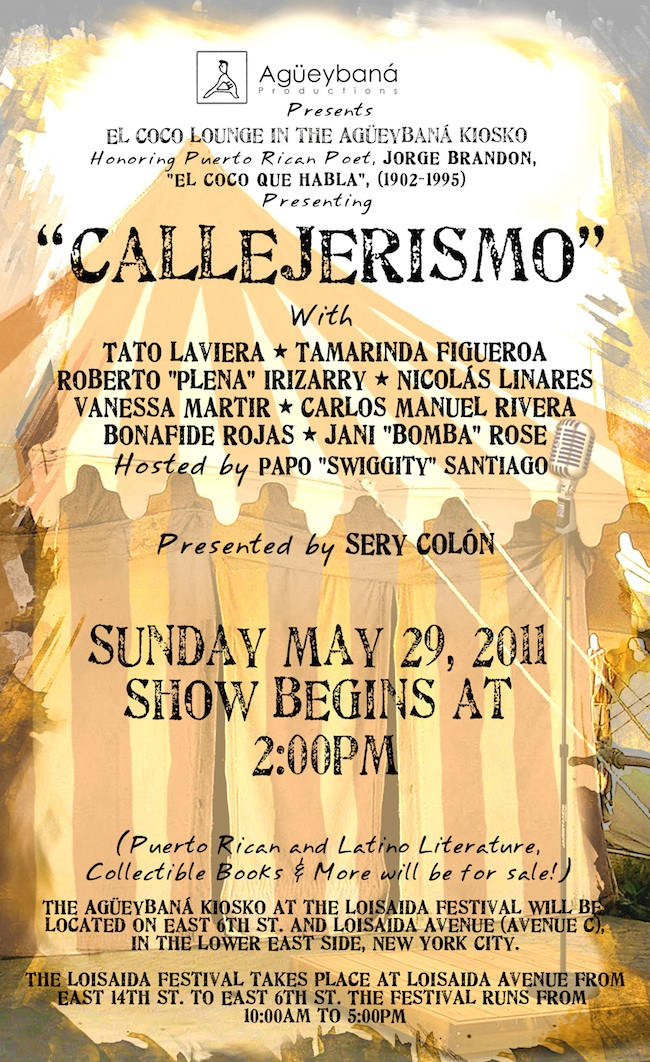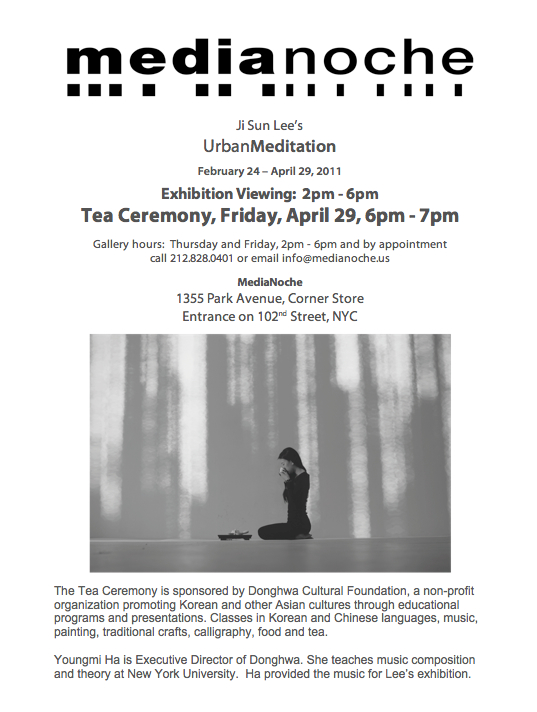From www.remezcla.com
[NY-CITY]
Reflexiones Post-Parada
BY Nuria Net | PUBLISHED: Tuesday, June 19th, 2007
ShareThis One Comment
“O te emboricueas o te abochornas!†Asà lo resumió mi amiga MarÃa T. Laboy y asà fue: we came, we saw, we conquered, gozamos y nos emboricuamos. Acá algunos de nuestras reflexiones después de ir a la Parada Puertorriqueña el 10 de junio del 2007. Considérese Parte II del artÃculo que postée hace dos semanas, “Perspectivas de la Parada Puetorriqueña.†Tampoco se pierdan las excelentes fotos tomadas ese dÃa en nuestra galerÃa de fotos. Y a los que todavÃa no se atreven a ir, vayan preparándose para el año que viene, porque vamos corillo de verdad.
Empecemos con MarÃa que sentó la pauta del emboricueo.
Hay de todo para todos, en todos lados…En las pasadas semanas leà este foro y escuché de mis amigos miles de opiniones acerca de la Parada Puertorriqueña, del tipo de gente que va y de lo que ocurre allÃ. A raÃz de esta retraÃla de opiniones, decidà ir de conejillo de indias a la bendita parada y documentar de forma visceral lo que mis sentimientos recibieran. Lo que empezó como una curiosidad de última hora terminó siendo el shot boricua de mi semana.
Este año no tenÃa planes ni mucho menos interés en ir a la parada. Mi pasada experiencia me dejó muy mal sabor. Solo habÃa ido una vez, el año pasado. Y como todo buen boricua de la isla me llene de “grÃngolasâ€. Luego de nadar en un mar de cafretones de todas las naciones, policÃas hostiles y un hambre desquiciada en espera de la ausente comida autóctona, terminé grandemente decepcionada y quejándome de todo. Pero este año, boricua al fin, en busca de una excusa para el “bembéâ€, no fue difÃcil sonsacarme para el segundo “try†a la parada.
Indudablemente este año fue diferente, dejée las grÃngolas a un lado y me llené de la humildad que deep down nos caracteriza a todos los puertorrros. Me dirigà a la parada bien tranquila, sin esperar nada en especÃfico, con la mente bien abierta. Como a eso de las 12:30, una hora y media luego de empezada la parada, puse pié fuera del subway. De inmediato se veÃan los rastros de boricualidad por todos lados. A medida que me acercaba a la Quinta Avenida para encontrarme con amistades, un swing se me metÃa por dentro. Estaba empezando a emboricuarme! Le llamo asà a una actitud especial que entiendo todos los puertorros pueden accesar si tienen suficientes ganas de pasarla bien, sin importar ocasión o clase social.
Nos espoteamos en la calle 70 con la Quinta Avenida. El mar de gente era tan impresionante como recordaba del año anterior. Un chorro de emociones pasaron por mi mente en las horas que estuvimos en aquella esquina de pie, viendo las carrozas de artistas pasar y la dinámica de la gente que me rodeaba. Sin embargo, la atracción mayor eran los personajes de boricuas bestiales que se veÃan pasar y sus formas tan creativas de llevar la monoestrellada. El momento se quedó marcado en mi mente con mil sentimientos encontrados, era muchas cosas a la vez, gracioso, interesante, insoportable, verdadero, musical, cultural, real. Inconscientemente me venÃa una sonrisita a la cara cada vez que miraba pa’l lado. Y esa sonrisa era la boricua bestial en mi, identificándose con el momento. La ricura del swing puertorro nos une, no importa que. Eso es estar emboricuao. Todos lo llevamos en la sangre, unos mas a flor de piel que otros.
Dichoso el que sé emboricuea sin problema, el que no se abochorna de ser mezcla de culturas, el que tiene un poquito de cafre, de comportado, de negro, de español y de indio taÃno. Dichoso el que vive en libertad social. AsÃ, que mi sugerencia para la parada del próximo año, es que acceses al boricua bestial que hay en ti y no te abochornes! Se siente bien!
Kit para emboricuarse en la Parada Puertorriqueña:
– Si eres boricua de la isla establecido en NY, llega temprano y espotéate en las calles de números altos de la 60th St. en adelante. Alli el gentÃo es manejable.
– Si crees que tu grado de boricualidad bestial es alto puedes caminar a las calles más abajo, mas cerca de la 42nd St.
– VÃstete de ropa casual, no es mandatario vestirte con la bandera, no te vas a sentir fuera de grupo.
– Asegúrate de no ir en “denialâ€, pensando en que la gente que estará allà no son borricuas. Si lo son y son reales.
– Escucha tres CD’s de salsa y reggaeton antes de ir, como para activar a al boricua pachanguero que hay en ti.
– Una vez termine la parada es un “must†terminar el dÃa comiendo criollo. Vete al restaurante El Deportivo que queda en la 48th St. y la Novena Avenida….te puedes encontar desde Ivy Queen hasta el mismÃsimo Gobernador de Puerto Rico, y más bestial que eso….
Nuria escribió:
Yo era la primera abochorná de la parada, pero este año fui y me la gocé completita. Mandé un email a mis amigos diciendo que la parada estaba hasta menos cafre este año, y varios me dijeron…no serás tú la cafre? Pues quizás sÃ, soy cafre y qué? O tal vez fue las tres horas de sueño despues de nacotearme con los mexicanos de nacotheque, o al estar familiarizada con cada reggaetonero y artista trepado en las carrozas (mi conocimiento de cultura pop aumenta con los años, quién dirÃa) pero me lo gocé de lo lindo.
También igual de divertido fue estar con celular casi sin baterÃa y tratando de reunir corillo en medio del rebolú. Me relamà los labios al ver a mis amigas experimentar la Parada por primera vez, al reÃrnos cuando pasaban polÃticos de la isla (Eduardo Bhatia, que haces por aquÃ?) que no pintan nada en Nueva York y nadie acá saben quienes son, al ver la corroza de LoÃza Aldea con todo y doña de Piñones con su varita de lechón (sÃ, recrearon eso en una carroza, y me parece haber visto bacalaÃtos también.) Llegó un punto que no me pude aguantar y gasté $3 en una bandera…con todo y dibujo de coquà para completar la bandera adulterada jamás no poder. Levanté la bandera, la tongonée y le dije a mis panas, con satisfacción y certeza, aunque medio incrédula “se siente bien! Se siente bien!â€
Familias enteras armadas con neveritas y sillitas de playas, con sus pinchos de pollo y su pan, jamón y queso. Señores, es igual de puertorriqueño que estar en la feria BacardÃ, en las Fiestas Patronales de Naranjito o esperando afuera de Plaza Las Américas al amanecer de Dios un viernes después de Thanksgiving.
Puerto Rico no tiene fiesta nacional, de independencia….y pues nos vamos a quedar con los brazos cruzados? No, tenÃan que ser los Nuyoricans, acá, los que se pueden dejar de politiquerÃas y dejar la vergüenza isleña y tirarse este tostón de celebrar ser boricua por la Quinta Avenida. Sólo por que sÃ.
Ya lo decidimos, allá comiéndonos unos mofongos de camarones en el Deportivo. El año que viene vamos a traer el Funky Float, para representar otro lado de ser puertorriqueño, la música rock y ponernos las telas. El Funky Float ideal tendrÃa a Circo de banda principal, Remezcla sponsoring, todos con vestidos de gala, Ednita Nazario, Yolandita y Dagmarita y Loubrielito. Más sugerencias bienvenidas.
Damian se atrevió a ir otra vez, y aunque no está 100% convencido, también gozó:
Si fui y la encontre menos cafre!! Por lo menos en cuanto a la gente, estaban más en “celebration mode†que en “cafre mode,†todo el mundo se llevaba bien.
Pero que conste, llegué tarde, como a las 4pm y recorrà el tramo sur de la Quinta Avenida hasta la 59 y hasta alli llegamos. Siempre que habia ido antes iba a el area de Central Park…
Mariel, quien no pudo ir este año, escribió:
Me estaba preparando para empezar en Seattle (ya regresé a nyc), otherwise I would’ve jumped in. Pero para mi fue un poco come le fue a Johanna — last year I even took Raúl, just the two of us, we got there early, got a GREAT spot, and the rumberos that set up right in front of us le enseñaron como tocar las congas a Raúl. Bailamos, comimos, saw Juelz Santana with Don Omar…it was AWESOME.
My first time I was visiting as a kid and I was a little overwhelmed. But my whole family ganged up and in the middle of that usual Jr. high identity crisis I was touched. Then, for years I thought it was ghetto and corny, now I think its beautiful and to hell with the haters. Especially when you pay close attention to the news on St Patrick’s Day (their parade is by far much drunker than ours)!
Any time you get thousands of people from the same place gathered in some other place, there will be drama. Though of course its clear that brown folks are profiled and targeted, oftentimes by our own…

